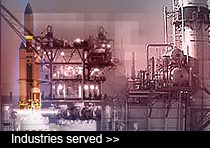KnightHawk Testing
KnightHawk offers both destructive and nondestructive testing, for all types of equipment. We also offer testing on materials and processes. Working in conjunction with our materials lab, we are able to offer a wealth of services to our clients. Below are some examples of how we have helped our clients with some critical testing issues.
Strain Gauging of Rotating Equipment Under Structural Load
KHE was hired to test the ability of a newly developed piece of equipment to withstand the designed loads under operating conditions (while rotating on a horizontal axis). Strain gauges were mounted on critical internal structural components. Representative loads were applied to the rotating components and the system was rotated while measurements were taken. The structural design was found to be adequate.
Hydrostatic Testing of a Pressure Vessel
KHE was hired to perform a hydrostatic test on a prototype of a pressure vessel, pressurizing the vessel to 150% of its 12,000 psi design pressure. The vessel was instrumented with strain gauges and pressurized to 18,000 psi. The measured strain was within tolerance of the code and no defects were detected.
High Pressure Plus Bending Moment Test of Sub Sea Flanges
KHE performed a Section VIII, Division 2 code assessment on a set of subsea flanges based on design conditions for a worst case of 12,000 psi operating pressure and 700,000 lbs. bending moment. Even though the design met code requirements, the client desired to test its prototype. The flanges were welded to 10 foot sections of the pipe and bolted together as if being installed in the final application. A test stand was set up to apply hydrostatic pressure and bending moment to 150% of the operating conditions. It held for 2 hours without leaks. The test units were instrumented with strain gauges as well as temperature and pressure gauges.
Testing for the Occurrence of Acoustic Pulsations in Process Line with Rotating Equipment
KHE performed testing to determine the underlying cause of repetitive compressor rotor damage. We suspected that destructive pressure pulsations within the suction and/or discharge chamber of the positive displacement compressor were causing the problem. To test this hypothesis, we mounted dynamic pressure transducers in the suction and discharge housing of the compressor and accelerometers on the bearing housings of the compressor rotor. The compressor was started up and put into production. Data was collected for several days and through several process changeovers. The data revealed that when the molecular weight of the process gas was shifted between 11 and 28, the acoustic conditions tuned in at a mole weight of approximately 18. The pressure pulsations that occur naturally in the system were amplified to catastrophic levels and wrecking the rotor. The process was modified to shutdown the compressor during process changeovers requiring mole weight swings crossing the critical weight.




